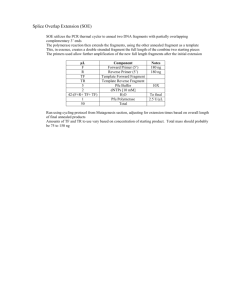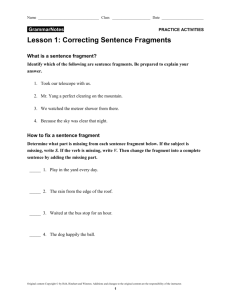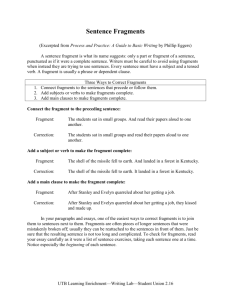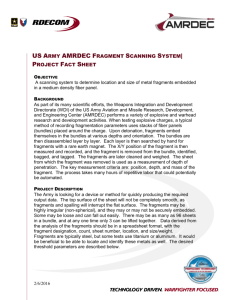Water Rocket Burst Test Report
advertisement
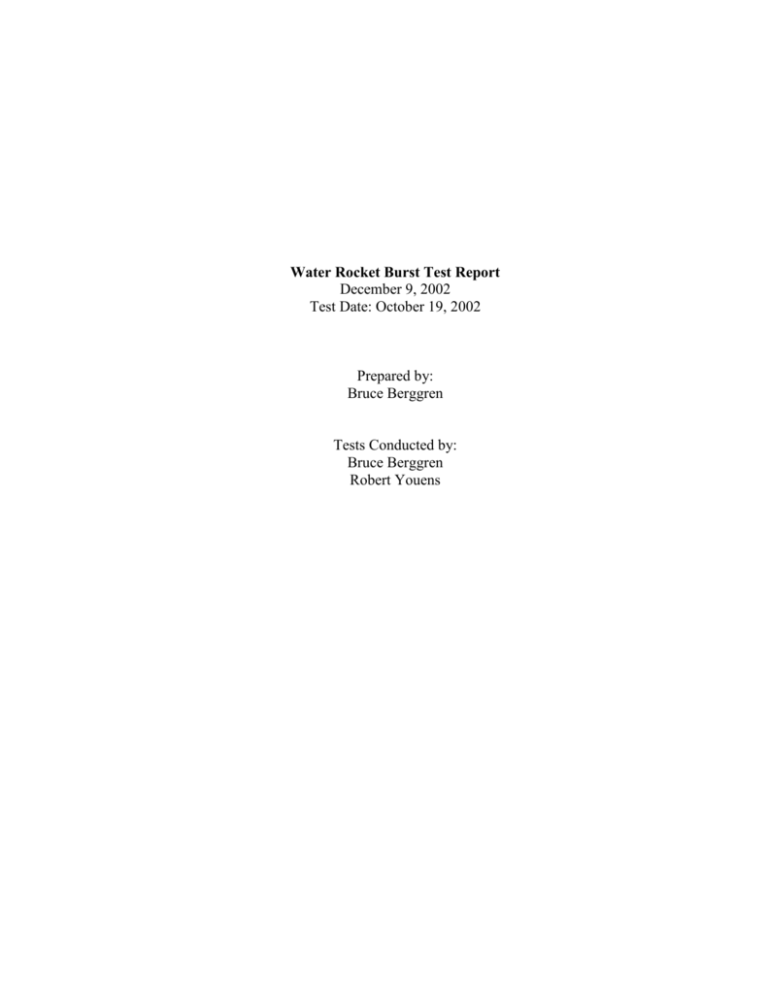
Water Rocket Burst Test Report December 9, 2002 Test Date: October 19, 2002 Prepared by: Bruce Berggren Tests Conducted by: Bruce Berggren Robert Youens Abstract This report describes four tests conducted to understand fragmentation hazards due to unexpected bursting of “water rockets”. These rockets are often constructed from used 2 or 3 liter polyethylene terephthalate (PET) bottles, and are widely used as educational tools or as a hobby rockets. Because there are currently no nationally accepted safety standards for water rockets, and since several commercial water rockets have been recalled due to bursting and associated injuries, it was desired to understand behavior of rocket fragments if a burst were to occur. These tests produced a ‘worst-case’ scenario by intentionally over pressuring a bottle having brittle plastic fins attached in the worst possible location by a weak adhesive. A large number of fragments were produced, and measured fragment velocities and trajectories were shown to compare favorably to those of a mathematical simulation. It is hoped that this information will be helpful in defining safe launch distance guidelines for this growing hobby. Purpose of Test The test is intended to answer the following questions. 1. At what pressure do PET bottles burst? 2. Do fins attached to the side of a PET bottle fragment in the case of a burst? 3. Does the bottle fragment into small pieces, or remain in one piece? 4. How far do the fragments travel? 5. How fast do the fragments travel? 6. Are measured fragment velocities and trajectories consistent with simulation predictions? Test Articles Figure 1. Typical Test Article A typical test article is shown in Figure 1. Five test articles were constructed. Four were tested (#1,2,4, and 5) and one (#3) was reserved for a future test. To simulate a typical water rocket, the articles were filled to approximately one-third full of water. 2 Bottle Size Large bottles were chosen to insure failure at reasonable pressures. Bottles in the 2-3 liter size were chosen to insure that our test equipment would be able to generate enough pressure to burst the bottles. It is expected that results from 2 and 3 liter bottles can be simulated, then extrapolated to other sizes and pressures. Fin Material The primary fragmentation concern is that fins attached to the side of the pressure chamber will be propelled outward by the force of the explosion. The most hazardous fins would be heavy and brittle, fragmenting into small pieces upon bursting. The plastic used for compact disks, or “CD’s”, was chosen to represent this type of material. Each fin is ¼ of a CD (1mm thick, 120mm diameter). Number of Fins To insure a large number of possible fragments, ten fins (two rows of 5) were attached around the cylindrical portion of the bottle. These were loosely attached using ‘hot glue’, which increases the likelihood that the fins will break free of the bottle to become projectiles. To insure visibility, the fins were painted red and numbered with a permanent marker. Test Setup Test Article Stand To insure good visibility and minimize ground interference with fragment trajectories, a clear, 1.6” diameter tube was used to support the test article approximately 2m (5 ft) above the pavement (see Figure 2.). Range markings were made every 5 ft from the stand, with full circles drawn at 20’ and 30’ (Figure 3). Figure 2. Test Article Stand Figure 3. Range Markings (feet) 3 Pressurization System Compressed gas was supplied from a CO2 cylinder, using both regulator low-side gage and an inline pressure gage for pressure measurement. Pressure was delivered to the test article through 50 ft of 1/4” diameter plastic tubing of the type used in drip irrigation systems. The tubing passed through a hole in the cap of the test bottle (for 3 liter bottles) or into a conventional “cable-tie” launcher (for 2liter bottles). Video Camera Location A Sony CCD-TRV16 8mm camcorder was used to record each test. Various ranges and view directions were tried to capture the event. The most useful camera angle is shown in Figure 5 (the camera was low enough to silhouette the test article against the sky). The camera was set to provide the highest possible shutter speed (“sports” mode), and left unattended on a tripod while the observers watched from a safer location (Figure 4). Figure 4. Pressurization System Figure 5. Video Camera Location – Test Article #5 Test Results Burst Pressures Burst pressures for the test articles were within the expected ranges. Table 1 lists the values obtained for each test article. Test Article: # 1 #2 #4 #5 Bottle Type: 2 liter 2 liter 3 liter 3 liter Pressure (psi): 150 180 150 140 Prior to bursting, each bottle grew in length and diameter as shown in the second photo in Figure 6. These photos were taken from a fixed position and are of the same scale. Just prior to failure, cracking sounds could be heard as the ‘hot glue’ fin adhesive began to disbond from the stretching bottle. All the fins remained attached until bursting. 4 Figure 6. Pressurization and Bursting of 3-Liter Test Article #4 Bottle Fragmentation In the final photo of Figure 6, the bottle has split and a large piece is visible in the lower right corner. In general, the bottles broke into three or four large, lightweight pieces. Fragments of the bottle sides are very thin and lightweight, and did not travel far (typcially found in the 10 to 20 ft zone). In some tests, the thicker bottle base separated from the sides. Since the base is heavier and is thrown upwards by the explosion, it was usually found farther away from the burst location (45 ft for test article #4). One fragment of test article #4 was found 18m (58 ft) downwind of the burst location. This chip (shown in Figure 7) weighed approximately 0.7 grams, and was approximately 2mm thick (twice as thick as the fin fragments). If a cable-tie type launcher had been used, it is likely that the cable ties and trigger ring would have prevented escape of this fragment. Missing Chip Figure 7. Bottle Fragments From Test Article #5 (left) and #4 (center, right) 5 Launcher Fragmentation The shock of a burst introduces a high lateral load into the launcher. In the first test using a 2-liter bottle (test article #2) a short piece of the launch tube (6” long, 5/8” diameter CPVC pipe) was snapped off at its base (Figure 8) and was found 28 ft away. The launch tube is not a critical part of the launcher. It extends up into the center of the bottle, acting as a guide similar to a launch rod in a conventional rocket. The same launcher was reused for the next test (article #1). This time, the entire launch head broke off, but remained clasped around the bottle. The assembly traveled less than 10 feet. None of the launcher parts broke into smaller pieces. Figure 8. Launcher Fragments From Test Articles #2 (left, center) and #1 (right) Fin Fragmentation In all cases, the brittle CD fins completely detached from the bottle and fractured into small pieces. In the third photo of Figure 6, fragments of the fin are clearly visible. Most fragments were of the size shown in Figure 9. Two fins on Test Article #4 were wrapped with fiberglass strapping tape, which reduced (but did not eliminate) their fragmentation. Figure 9. Typical Fin Fragments Due to the number of fragments, it was not possible to measure and record the position of each. After the first burst, a search for fragments was made and chalk circles drawn around each. A camcorder was then used to document the resulting locations and observations. After each subsequent burst, a similar inspection was performed. After the final (fourth) burst, another thorough search was made to identify fragment locations. Particular attention was focused on the outer perimeter area. The distribution of fragment distances from all four tests was estimated in Table 1 below. 6 Distance 20-30 ft 30-40 ft 40-50 ft 50-60 ft 60-70 ft 70-80 ft Number Downwind ~50 ~20 ~10 ~3 ~2 ~2 Number Upwind ~50 ~15 ~5 ~0 ~0 ~0 This is only a rough estimate, and we clearly did not find all the fragments. The paved area of the abandoned runway was approximately 80 ft wide, and we believe some of the fragments were lost in the tall grass beyond the edge of the runway. There was no noticeable correlation between fragment size and distance traveled - both small and large fragments were found more-or-less evenly distributed around the area. This is not surprising, since the terminal velocity of the fragments (proportional to mass divided by area) is independent of fragment size. Fragment Velocity Videotape data from the burst of Test Article #5 can be used to estimate initial fragment velocity. Figure 10 shows the first 3 frames of video. Both positive and negative images are shown to help highlight fragment locations. The first frame shows the expanding cloud of CO2 just after bursting of the bottle. The fins are enveloped in the cloud, and are being accelerated as the gas rushes by. In the second frame, the gas cloud has slowed while the fin fragments continue to move outward. In the third frame, several of the fastest fragments are no longer visible, and the larger, slower ones continue to move away from the burst location. A short .avi video of a burst can be viewed at http://www.geocities.com/wrgarage/5burst.avi . Screen snapshots are shown on the following page. 7 t = 0.000+ sec t = 0.033 sec t = 0.067 sec Figure 10. Videotape Data - Fragment Position vs. Time Data 8 Figure 11. Fragment Positions 0.033 and 0.067 seconds after burst Figure 11 shows frame 2 and 3 with twenty-eight (28) fragments identified and highlighted with colored circles. A trailing line shows the distance traveled in 1/30th of a second. From t = 0.000 to t = 0.033, two small fragments have traveled at least 3 meters, an average speed of 90 m/s (~200 mph). In successive frames, the fastest particles have left the field of vision, and the remaining fragments appear to be moving at approximately 50 m/s (110 mph). Prediction of Fragment Velocities Equating the stored energy in the compressed gas and the kinetic energy of the fragments results in a reasonable estimate of fragment initial velocities. The ballistic behavior of the fragments can then be calculated based on an assumed area, mass, and drag coefficient. A number of assumptions are necessary to complete the calculation: 1. Assume all fragments travel radially (a cylindrical, not spherical pattern) 2. Assume all fragments achieve the same initial velocity. 3. Assume all the stored energy is transferred to fragments. 4. Assume fins behave as fragments from a cylindrical pipe having the same thickness. 5. Assume a Cd of 0.8 for all fragments 6. Assume the fragments stop when contact with the ground occurs. Assumption 3 is highly conservative, balancing the slightly unconservative assumption #2. The net conservatism here results in the simulation being a good predictor of MAXIMUM fragment velocity and distance. Appendix A shows the equations used to predict initial velocity for Test Article #5. Once the initial velocity was known, the effects of aerodynamic drag and drift due to wind were accounted for in a MathCAD simulation using closed form equations. An Excel spreadsheet was created to verify the accuracy of the closed form approach, and both methods produced nearly identical predictions. The Excel simulation produces both altitude and range predictions, and is also able to account for the effect of wind. Trajectory plots for various initial fragment directions (15, 45, and 75 degrees from horizontal) are shown in Figure 12. 9 Figure 12. Excel Simulation Results for Test Article #5 Figure 13 Simulation vs. Actual Fragment Distance – Test Article #5 10 Comparison to Simulation For Test Article #5, the simulation predicts that fin fragments will travel just over 3 meters in 0.033 seconds. This appears to be a conservative velocity prediction, as shown in Figure 13. The simulation predicted that fragments would travel 14m (46 ft). While most fragments fell within a 10m (30 ft) circle, we did find two fragments that exceeded the predicted distance- one at 15m (50 ft) and one at 16m (54 ft). Variability of fragment shape, spin, wind speed, and the fact that some fragments were seen to roll along the ground all complicate the ability to accurately predict the final fragment positions. For Test Article #4, the simulation predicted 14m (46 ft) for 1mm thick fin fragments. As noted earlier, a 2mm thick bottle fragment was found 58 ft away. Entering the larger thickness value into the simulation resulted in improved accuracy (predicted 72 ft). A similar simulation of Test Article #2 predicted a 20m (65 ft) fragment throw distance. One fragment was found at 25m (81 ft). Larger distances occurred in the burst of #2 (relative to #5) because of the higher burst pressure (180 vs. 140psi) and the higher wind speed (~10mph vs. ~5mph). Distance travelled ended up being quite sensitive to wind speed. Conclusions: The objectives of this test were achieved. Several additional observations are as follows: 1. Items attached to the side of a bursting bottle may pose a significant safety risk in the event of a burst. Safety guidelines are needed (maximum pressure limits, fin material restrictions, minimum distance limits, or eye protection). 2. PET bottle fragments pose a low safety risk since they produce a small number of large, lightweight fragments that slow quickly. 3. PVC launchers may be damaged by a burst, but their initial location at the center of the burst prevents launcher fragments from travelling as far or as fast as fin fragments. 4. The simulation proposed is a good indicator of MAXIMUM fragment velocities and distances. The AVERAGE fragment velocities and distances will be lower since only part of the compressed gas energy is converted to fragment kinetic energy. The results of this test should provide a good foundation for future tests or decisions regarding safe water rocket launch distances. Acknowledgements: The author wishes to recognize the contributions of Robert Youens for his assistance in performing and recording these tests. Robert also serves as the National Director for Science Olympiad (Bottle Rocket Division), where he is effectively promoting water rocketry to encourage student interest in science education. The National Association of Rocketry is also acknowledged for its dedication to science education through the use of hobby rocketry, and their efforts to accommodate water rocketry at their launch events. The NAR is considering the adoption of a Water Rocket Safety Code to supplement their existing Model Rocket Safety Code, and this effort is the primary motivation for this research. Bruce Berggren 11 Appendix A: Simulation Equations (Evaluated with MathCAD 6.0, which handles units conversions painlessly) Input Values 1. atm p atm k 1.3 (for C02) dia 5. in p gage 140. psi length 1. m (note: since fragment velocity is not a function of length, a unit value is used) kg air_density 1.2. 3 m Fragment Properties 1. mm frag_thk kg 1300. 3 m frag_density Cd .8 Velocity Calculations: 1 vol initial energy 2 . dia . length 4 p atm. vol final frag_area vol final p atm . vol initial p gage 1 k frag_thk) . length . ( dia p atm. vol final p gage p atm k p atm vol initial frag_area. frag_thk. frag_density frag_mass 2. energy initial_velocity vol initial. initial_velocity = 217.026 m sec 1 frag_mass i. m rangei 0, 2.. 20 range . air_density. Cd. frag_area i 2. frag_mass 2. energy . e frag_mass velocityi 3 1 10 Fragment Velocity (m/s) i 100 velocity i 10 1 0.1 0 2 4 6 8 10 12 14 16 18 20 range i Distance from burst (m) 12 Appendix B: Safe-Distance Recommendations The National Association of Rocketry has no control over the design or use of consumer products. However, NAR provides safety guidelines that members must follow if they wish to be covered under NAR’s liability insurance. Because water rockets have different failure modes than conventional rockets, it will be in the best interest of all involved if the NAR publishes a safety code specifically targeted to water rockets, that insures the low probability of injuries. Current consumer water rocket products do not appear to be following any 'safe distance' standard whatsoever. As a result many recent products have caused injuries and have been recalled. Hyperlinks to several examples are shown below (search for ‘rocket’ at www.cspc.gov). Estes Air Rocket Recalled (http://www.cpsc.gov/CPSCPUB/PREREL/prhtml02/02142.html) SpinMaster Splash Blast Recalled (http://www.cpsc.gov/CPSCPUB/PREREL/prhtml01/01158.html) Ohio Arts SplashOff Recalled (http://www.cpsc.gov/CPSCPUB/PREREL/PRHTML97/97160.html) During email discussions attempting to define appropriate safety criteria, it was reported that the Consumer Product Safety Comission’s rule-making goal was “to reduce the analytic probability of risk to as close to zero as can be achieved (1 in a million is typical)". This wording is so conservative and subjective that it seems nearly impossible to satisfy. For example, what is a “probability of a risk”? Risk of what (injury? blindness? death?). For a burst ocurring at a high pressure (~150psi), on a windy day, it appears likely that some fragments could travel up to 100 ft, and this distance would reduce risk to ‘close to zero’. The author belives that such a distance requirement is unrealistic and inconsistent with distances being used in conventional rocketry, Science Olympiad water rocket competitions, and all existing consumer water rockets. At the other extreme, DOD 6055.9-STD (Department of Defense Ammunition and Explosives Safety Standards) allows the public to be exposed to one hazardous fragment per 600 sq. ft of frontal area in the event of an unintentional explosion. A “hazardous fragment” is further defined as one having a kinetic energy 58 ft-lb (79 N-m). For comparison, a .22 long rifle bullet contains about twice this amount of kinetic energy*. The test videotape and simulation indicate that none of the fin fragments tested ever contained this much energy. The author believes that this criterion is not conservative enough, especially when higher pressures or modified pressure chambers increase the risk of a burst. *http://www.chuckhawks.com/22_rimfire_cartridges.htm A reasonable definition of “safe-distance” would be that which insures fragments have slowed to their terminal velocity. Although the fragments may continue to travel some distance, they are typically drifting with the wind or following a high, arcing trajectory by this time, and are thus unlikely to cause injuries. For fins made of 1mm thick plastic, the terminal velocity is 5 m/s (12 mph). Simulation of a 150 psi burst shows that fragments slow to this velocity at a distance of approximately 30 ft. A primary concern should be likelihood that a fragment might hit an observer without eye protection. It is possible that a broken piece of bottle flange (2mm thick) may be propelled farther than the 30 ft launch radius (as we saw in test article #4). Unlike fragments from brittle plastic fins (which may number in the hundreds), thick bottle fragments are extremely rare (we saw one fragment in all our tests, which arguably would have been contained by the launcher had one been used). The ‘one in a million’ criteria could be satisfied at 30 ft, if we made some assumptions and statistical calculations. 13 -Assume that the burst rate is 1 per 50 launches. -Assume that every burst would produce one heavy fragment (i.e. a bottle flange 2mm thick). -Assume the fragment stays within a +/- 10 degree angle from horizontal. -Assume the observer does not blink in reaction to the noise caused by the burst. At a distance of 30 ft, the possible locations of the fragment fall within a cylindrical ‘window’ of height 2*30’*tan(10deg)=10.6 ft and circumference (*30ft) =94 ft. The probability that an observer would be hit in an eye (about 1 sq. inch) is roughly Probability = (1burst/50launches)*(1fragment/burst)*[1sq. in / (10.6ft*94ft*144)] = 1 in 7 million launches To permit observers as close as 15 feet while satisfying a ‘one in a million’ safety goal would require additional measures such as: -eye protection OR -reduced pressures (to reduce failure probablilty) OR -a burst screen between the rocket and observers OR (any other ideas?) Requiring a 30 ft standoff distance is not likely to be popular with launcher manufacturers, since most do not have a 30 ft pressurization line. Requiring eye protection is not likely to be popular with the NAR, since it will be difficult to enforce. This type of analysis is not an exact science, and the answer derived here is no more accurate than the initial assumptions. If it is any consolation, fifty feet of drip irrigation tubing can be purchased at a hardware store for about $5. Bruce Berggren December 9, 2002 14


